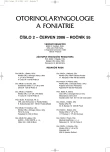Nodular Cervical Metastases of Spinocellular Carcinoma of Oropharynx and Pharynx (Part 1)
Authors:
P. Praženica; J. Lacman 1; R. Holý; M. Navara; Z. Voldřich
Authors‘ workplace:
Otorinolaryngologické oddělení, Ústřední vojenská nemocnice Praha
přednosta plk. MUDr. M. Navara
Radiodiagnostické oddělení, Ústřední vojenská nemocnice Praha
; přednosta pplk. MUDr. F. Charvát
1
Published in:
Otorinolaryngol Foniatr, 55, 2006, No. 2, pp. 103-107.
Category:
Original Article
Overview
Summary:
The authors present a prospective study aimed at the evaluation of palpation, ultrasonography (USG), computing tomography (CT) and nuclear magnetic resonance (MRI) in the diagnostics of cervical metastases of spinocellular carcinoma (SCC) of oropharynx and pharynx. The study included 49 patients with SCC of oropharynx or pharynx over the period of 2.5 years with the following criteria for cervical metastases: 1. Maximum transverse dimension of lymphatic node > 15 mm in the sector I and > 10 mm in other sectors. 2. L/T quotient < 2 (ratio between the maximum longitudinal and maximal or minimal transverse diameter of the lymphatic node). 3. A group of three or more mutually unbounded lymphatic nodes of the size between 8 and 10 mm. 4. Central necrosis. 5. Extranodal dissemination. The sensitivity of palpation proved to be 53% and the specificity 67%. USG reached sensitivity and specificity 74% alike according to the criterion of size, sensitivity of 79% and specificity of 93% was reached according to L/T quotient and sensitivity of 90% and specificity of 98% was reached according to central necrosis. A common combination of all USG criteria revealed sensitivity of 85% and specificity of 87%. In selecting the criterion of the size CT and MRI proved to reach sensitivity of 71% and 78%, respectively and specificity of 90% and 85%, respectively. The central necrosis displayed sensitivity of 88% and 89% and specificity of 99% and 96% for CR and MRI, respectively. In the combination of all criteria the authors reached sensitivity of 75% for CT and 78% for MRI and specificity of 87% for CT and 85% of MRI. The authors arrived at the conclusion that the diagnostics of nodular cervical metastases on the basis of palpation is insufficient. The results obtained by USG diagnostics are reliable. The diagnostic value of L/T quotient and central necrosis is high. The diagnostic possibilities of CT and MRI proved to be similar. A common combination of all criteria proved to be best for all techniques. The presumption of a rapid improvement in the detection of nodular cervical metastases on the basis of CT and MRI examinations has not been confirmed and USG proved to be even more useful in some parameters of evaluating nodular affection.
Key words:
cervical dissection, nodular cervical metastases, palpation, ultrasonography, computing tomography, nuclear magnetic resonance.
Labels
Audiology Paediatric ENT ENT (Otorhinolaryngology)Article was published in
Otorhinolaryngology and Phoniatrics

2006 Issue 2
Most read in this issue
- Tonsicellectomy in the Cold and Warmth
- Nodular Cervical Metastases of Spinocellular Carcinoma of Oropharynx and Pharynx (Part 2)
- Mucosal Melanomas of the Head and Neck
- Surgical Treatment of Cholesteatoma
